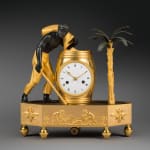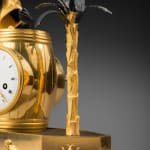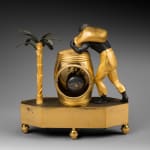Jean-Simon Deverberie (attributed to) 1864-1824
Further images
Literature
Dominique and Chantal Fléchon, “La pendule au nègre”, in Bulletin de l’Association nationale des collectionneurs et amateurs d’horlogerie ancienne, Spring 1992, n° 63, p. 41.
Today, only a few rare similar examples are known. Among them, one example was sold by
Sotheby’s London on December 5, 1980, lot 127. A second example is illustrated in P. Kjellberg, Encyclopédie de la pendule française du Moyen Age au XXe siècle, Paris, 1997, p. 344. A further similar example, whose dial is signed Gamot à Lille, is illustrated in E. Niehüser, Die französische Bronzeuhr, Munich, 1997, p. 156.
A superb Empire gilt and patinated bronze ‘Pendule ‘au nègre’ ‘The coffee Bearer’attributed to Jean-Simon Deverberie
The enamel dial indicates the hours in Roman numerals, with fifteen-minute and Arabic minute graduations, indicated by a fine pair of chased gilt bronze hands. The dial is set in a gilt bronze barrel into which a young black man is pouring a sack full of coffee. His finely chiselled features, torso and members are beautifully rendered; the face is particularly expressive, with life-like enamelled eyes. A naturalistic palm tree lends elegance and balance to the composition. The octagonal chased gilt bronze base is decorated with low-relief bees and a scene depicting children gathering bundles of sticks. The whole is raised upon five finely beaded oval feet.
Paris, date 1795 - 1800
Height 29 cm; width 29 cm; depth 9.5 cm
Until the late 18th century, clocks based on the theme of the “noble savage” were rare in French and European horology. It was not until the end of the Ancien Régime – more precisely during the last decade of the 18th century and the early years of the following century, that the first “pendules au nègre” appeared. They reflect a philosophical current that was articulated in literary and historical works of the day. Among them are Bernardin de Saint-Pierre’s Paul et Virginie, published in 1787, which portrays the innocence of the main characters; Chateaubriand’s Atala, which defends Christian ideals; and Daniel Defoe’s masterwork, Robinson Crusoé, which was published in 1719.







